Comparison of the Application of Three Methods for the Determination of Outdoor PM2.5 Design Concentrations for Fresh Air Filtration Systems in China
Abstract
1. Introduction
2. Methods
2.1. Data Sources
2.2. The Method for No-Guarantee Days
2.3. The Method of Guarantee Rate
2.4. The Method of Mathematical Induction
2.5. The Method of Air Filter Selection
3. Results and Discussion
3.1. Outdoor Concentration of PM2.5
3.2. The Change in PM2.5 Concentration Using the Method of No-Guarantee Days
3.3. The Change in PM2.5 Concentration Using the Method of Guarantee Rate
3.4. The Change in PM2.5 Concentration Using the Method of Mathematical Induction
3.5. Analysis and Suggestions Regarding the Calculation Results of Three Methods
4. Conclusions
- The results of the method of no-guarantee days showed relatively large changes, and the data were prone to rebound, which leads to large errors when calculating the outdoor PM2.5 concentration. The outdoor PM2.5 concentration values corresponding to no-guarantee for 5 days were obtained under the strict requirements of the environment. The outdoor PM2.5 concentration values corresponding to no-guarantee for 10 days were obtained under the normal requirements of the environment. It is recommended to use the average data over a period of years to increase accuracy.
- The required outdoor PM2.5 design concentration value of any guarantee rate for each city could be obtained according to the guarantee rate curve that is drawn. This satisfies the requirements for environmental control under different guarantee rates. In addition, the guarantee rate was more complicated and used more steps.
- When the method of mathematical induction is used, the recommended coefficient K should be given separately, according to the region. Different provinces and cities need different recommendations for coefficient K. The recommended coefficient K could be divided into values for strict conditions and normal conditions in practice.
- It is more appropriate to use the method of mathematical induction to calculate the outdoor PM2.5 design concentration for fresh-air filtration. The outdoor PM2.5 design concentration in a given location can be quickly obtained using the values of K and annual average concentration. The recommended K is obtained by calculating the average of the existing monitoring data for provincial capital cities. This could effectively solve the current limited availability of urban atmospheric PM2.5 concentration data values for analysis, making this method more suitable for use in China. It provides a reference value for the method to quickly determine the outdoor PM2.5 design concentration for fresh-air filtration systems.
Author Contributions
Funding
Institutional Review Board Statement
Informed Consent Statement
Data Availability Statement
Conflicts of Interest
References
- Tian, Y.L.; Li, X.Y.; Sun, H.T.; Xue, W.H.; Song, J.X. Characteristics of atmospheric pollution and the impacts of environmental management over a megacity, northwestern China. Urban Clim. 2022, 42, 101114. [Google Scholar] [CrossRef]
- Chen, Q.; Luo, X.S.; Chen, Y.; Zhao, Z.; Hong, Y.W.; Pang, Y.T.; Huang, W.J.; Wang, Y.; Jin, L. Seasonally varied cytotoxicity of organic components in PM2.5 from urban and industrial areas of a Chinese megacity. Chemosphere 2019, 230, 424–431. [Google Scholar] [CrossRef]
- Zhang, X.; Fan, Y.S.; Wei, S.X.; Wang, H.; Zhang, J.X. Spatiotemporal Distribution of PM2.5 and Its Correlation with Other Air Pollutants in Winter during 2016~2018 in Xi’an, China. Pol. J. Environ. Stud. 2021, 30, 1457–1464. [Google Scholar] [CrossRef]
- Zhang, X.; Fan, Y.S.; Yu, W.Q.; Wang, H.; Zhang, X.L. Variation of Particulate Matter and Its Correlation with Other Air Pollutants in Xi’an, China. Pol. J. Environ. Stud. 2021, 30, 3357–3364. [Google Scholar] [CrossRef]
- Hu, Y.J. Environmental Behavior and Human Inhalation Exposure of Particles and Typical Organic Contaminants in Indoor and Outdoor Air. Ph.D. Thesis, University of Chinese Academy of Sciences, Guangzhou, China, 2018. (In Chinese). [Google Scholar]
- Bu, S.B.; Wang, Y.L.; Wang, H.Y.; Wang, F.; Tan, Y.F. Predicting spatio-temporal distribution of indoor multi-phase phthalates under the influence of particulate matter. Built Environ. 2022, 221, 109329. [Google Scholar] [CrossRef]
- Zhou, F.R.; Yang, J.R.; Wen, G.; Ma, Y.; Pan, H.; Geng, H.; Cao, J.; Zhao, M.; Xu, C. Estimating spatio-temporal variability of aerosol pollution in Yunnan Province, China. Atmos. Pollut. Res. 2022, 13, 101450. [Google Scholar] [CrossRef]
- Burnett, R.T.; Spadaro, J.V.; Garcia, G.R.; Pope, C.A. Designing health impact functions to assess marginal changes in outdoor fine particulate matter. Environ. Res. 2022, 204, 112245. [Google Scholar] [CrossRef]
- Xie, W.; Fan, Y.S.; Zhang, X.; Tian, G.J.; Si, P.F. A mathematical model for predicting indoor PM2.5 concentration under different ventilation methods in residential buildings. Build. Serv. Eng. Res. Technol. 2020, 41, 694–708. [Google Scholar] [CrossRef]
- Stephens, B. Building design and operational choices that impact indoor exposures to outdoor particulate matter inside residences. Sci. Technol. Built Environ. 2015, 21, 3–13. [Google Scholar] [CrossRef]
- Martins, N.R.; da Graça, G.C. Impact of outdoor PM2.5 on natural ventilation usability in California’s nondomestic buildings. Appl. Energ. 2017, 189, 711–724. [Google Scholar] [CrossRef]
- Awada, M.; Becerik-Gerber, B.; White, E.; Hoque, S.; O’Neill, Z.; Pedrielli, G.; Wen, J.; Wu, T. Occupant health in buildings: Impact of the COVID-19 pandemic on the opinions of building professionals and implications on research. Built Environ. 2022, 207, 108440. [Google Scholar] [CrossRef] [PubMed]
- Zhang, X.; Fan, Y.S.; Wei, S.X.; Wang, H.; Zhang, J.X.; Yu, W.Q. Experimental study on particle deposition in pipelines in a fresh air system. Therm. Sci. 2021, 25, 2319–2325. [Google Scholar] [CrossRef]
- Zhang, X.; Fan, Y.S.; Zhang, J.X.; Wang, H.; Wei, S.X.; Yu, W.Q. Selection of air filters for residential fresh air in China based on the control of PM2.5. Therm. Sci. 2021, 25, 2311–2318. [Google Scholar] [CrossRef]
- Wang, Q.Q.; Fan, D.Y.; Zhao, L.; Wu, W.W. A Study on the Design Method of Indoor Fine Particulate Matter (PM2.5) Pollution Control in China. Int. J. Environ. Res. Public Health 2019, 16, 4588. [Google Scholar] [CrossRef] [PubMed]
- Zhang, X.; Fan, Y.S.; Zhang, J.X.; Wang, H.; Wei, S.X. Research on outdoor design PM2.5 concentration for fresh air filtration systems based on mathematical inductions. J. Build. Eng. 2021, 34, 101883. [Google Scholar] [CrossRef]
- Xiong, Z.J.; Lin, J.Y.; Li, X.H.; Bian, F.G.; Wang, J. Hierarchically Structured Nanocellulose-Implanted Air Filters for High-Efficiency Particulate Matter Removal. ACS Appl. Mater. Interfaces 2021, 13, 12408–12416. [Google Scholar] [CrossRef]
- Zhong, X.Y.; Wu, W.; Ridley, I.A. Assessing the energy and indoor-PM2.5-exposure impacts of control strategies for residential energy recovery ventilators. J. Build. Eng. 2020, 29, 101137. [Google Scholar] [CrossRef]
- Liu, C.; Hsu, P.C.; Lee, H.W.; Ye, M.; Zheng, G.Y.; Liu, N.; Li, W.Y.; Cui, Y. Transparent air filter for high-efficiency PM2.5 capture. Nat. Commun. 2015, 6, 6205. [Google Scholar] [CrossRef]
- Zhou, Y.J.; Liu, Y.N.; Zhang, M.X.; Feng, Z.B.; Yu, D.G.; Wang, K. Electrospun Nanofiber Membranes for Air Filtration: A Review. Nanomaterials 2022, 12, 1077. [Google Scholar] [CrossRef]
- Yang, H.Y.; Deng, H.Z.; Zhai, L.S.; Deng, B. Potential Natural Fibrous Filter against PM2.5 from Juncus Effuses. J. Nat. Fibers 2022, 19, 1048–1054. [Google Scholar] [CrossRef]
- Yu, W.; Wang, L.X.; Wang, Q.Q.; Wang, X.F.; Li, G.Z.; Wang, J.L.; Awbi, H. Design selection and evaluation method of PM2.5 filters for fresh air systems. J. Build. Eng. 2020, 27, 100977. [Google Scholar] [CrossRef]
- Wu, Y.Q.; Chen, C.; Chen, Z.G.; Hao, Z.Y.; Lin, J. Discussion on determination method of mass concentration calculation of outdoor fine particulate matter (PM2.5). HVAC 2019, 49, 83–87+55. (In Chinese) [Google Scholar]
- Tu, G.B.; Tu, Y.; Liu, B.; Zhou, Y.B. Corresponding problems for outdoor design concentration of fine particulate (PM2.5). HVAC 2016, 46, 70–74. (In Chinese) [Google Scholar]
- Martins, V.; Faria, T.; Diapouli, E.; Manousakas, M.I.; Eleftheriadis, K.; Viana, M.; Almeida, S.M. Relationship between indoor and outdoor size-fractionated particulate matter in urban microenvironments: Levels, chemical composition and sources. Environ. Res. 2020, 183, 109203. [Google Scholar] [CrossRef] [PubMed]
- Wang, Q.Q.; Li, G.Z.; Zhu, R.X.; Wang, J.L.; Zhao, L. Determination of PM2.5 outdoor design concentration for air filter design and selection. Build. Sci. 2015, 31, 71–77. (In Chinese) [Google Scholar]
- GB/T18883-2020; Indoor Air Quality Standard. National Standard of the People’s Republic of China; China Standard Press: Beijing, China, 2020.
- GB 3095-2012; Ambient Air Quality Standards. National Standard of the People’s Republic of China; China Environmental Science Press: Beijing, China, 2012.
- Li, C.; Zhang, L.; Gu, Q.Y.; Guo, J.; Huang, Y. Spatio-Temporal Differentiation Characteristics and Urbanization Factors of Urban Household Carbon Emissions in China. Int. J. Environ. Res. Public Health 2022, 19, 4451. [Google Scholar] [CrossRef]
- Zhang, H.L. Experimental Study of Filters of Different Grades on Outdoor Airborne Particulate Matter. Master’s Thesis, Xi’an University of Architecture and Technology, Xi’an, China, 2018. (In Chinese). [Google Scholar]
- Xie, W.; Fan, Y.S.; Yu, J.W.; Zhang, X.; Si, P.F. Feature analysis of indoor particulate matter concentration using fiber filtration for mechanical ventilation. J. Eng. Fiber Fabr. 2020, 15, 1–9. [Google Scholar] [CrossRef]
- Zhang, X.L. Study on the Method of Determining the Design Concentration of Ventilation Outdoor PM2.5. Master’s Thesis, Xi’an University of Architecture and Technology, Xi’an, China, 2019. (In Chinese). [Google Scholar]
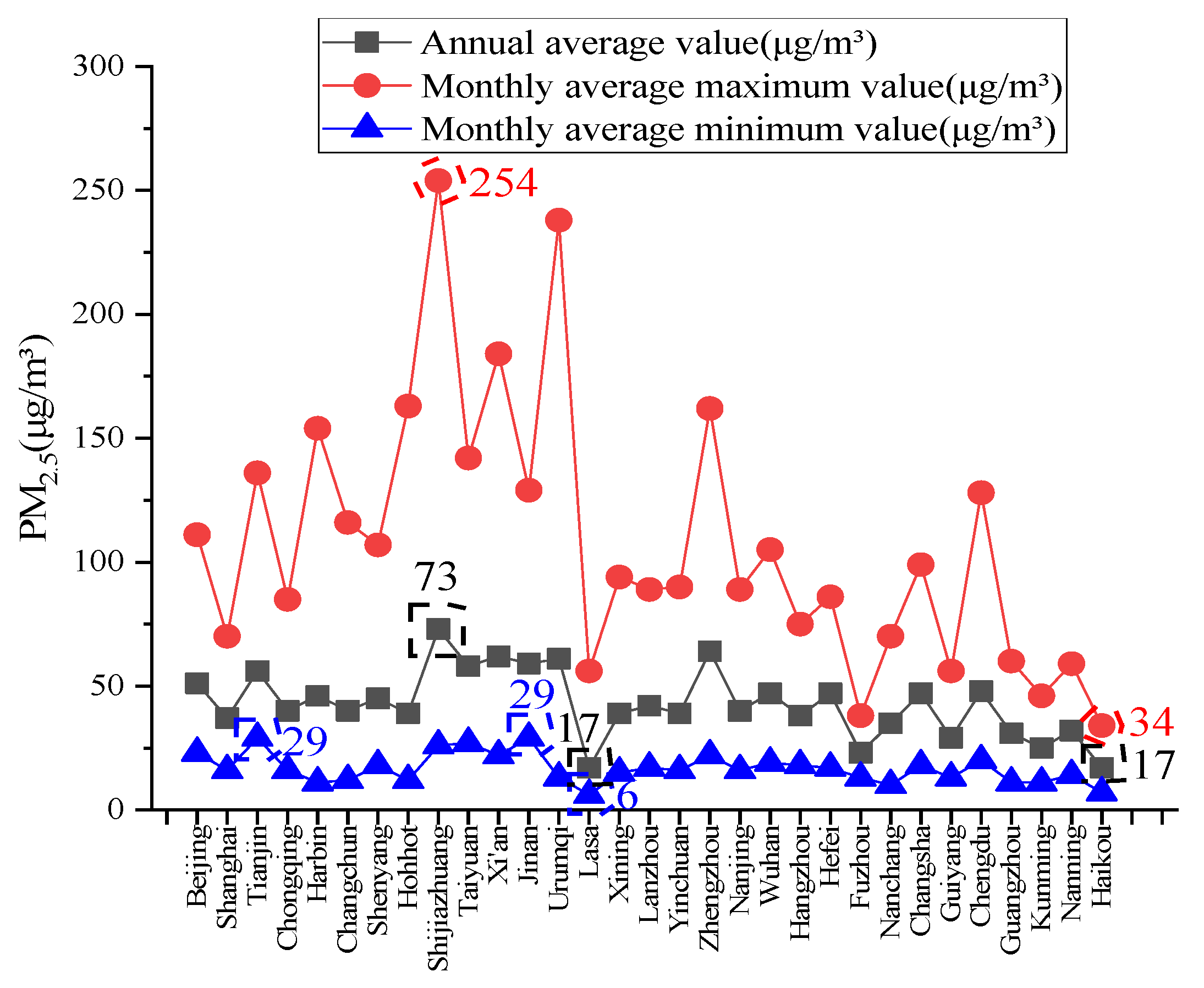
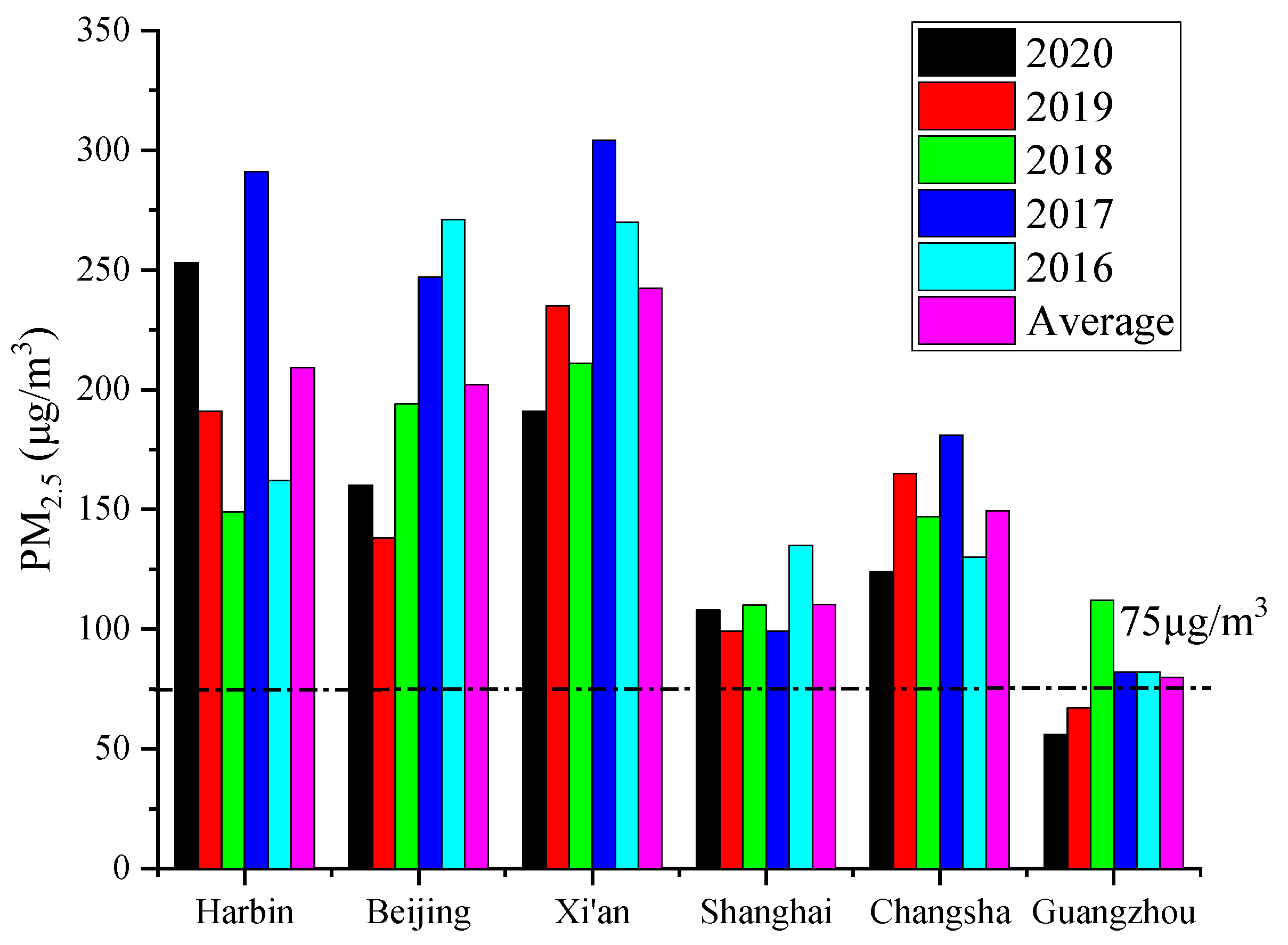
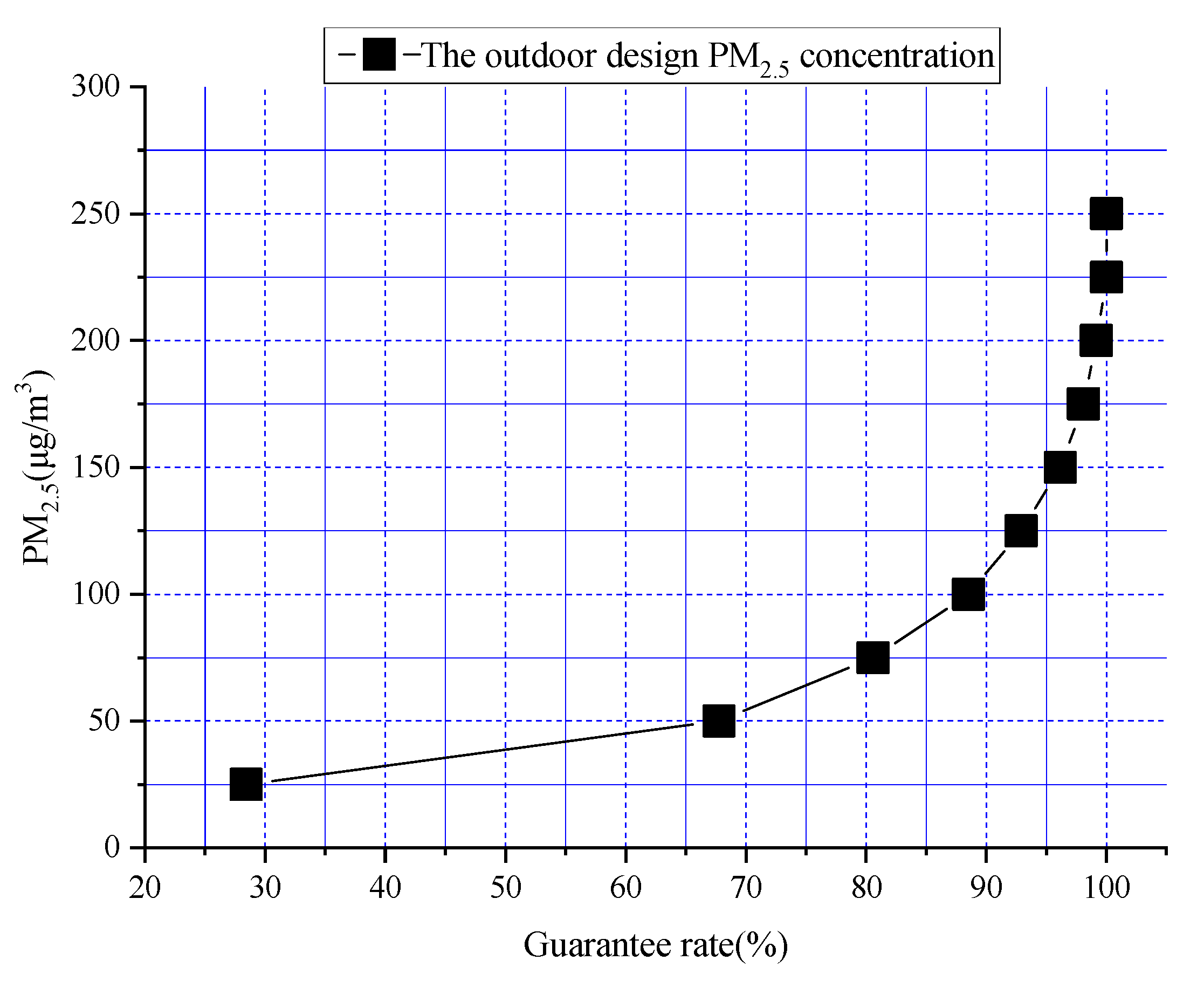

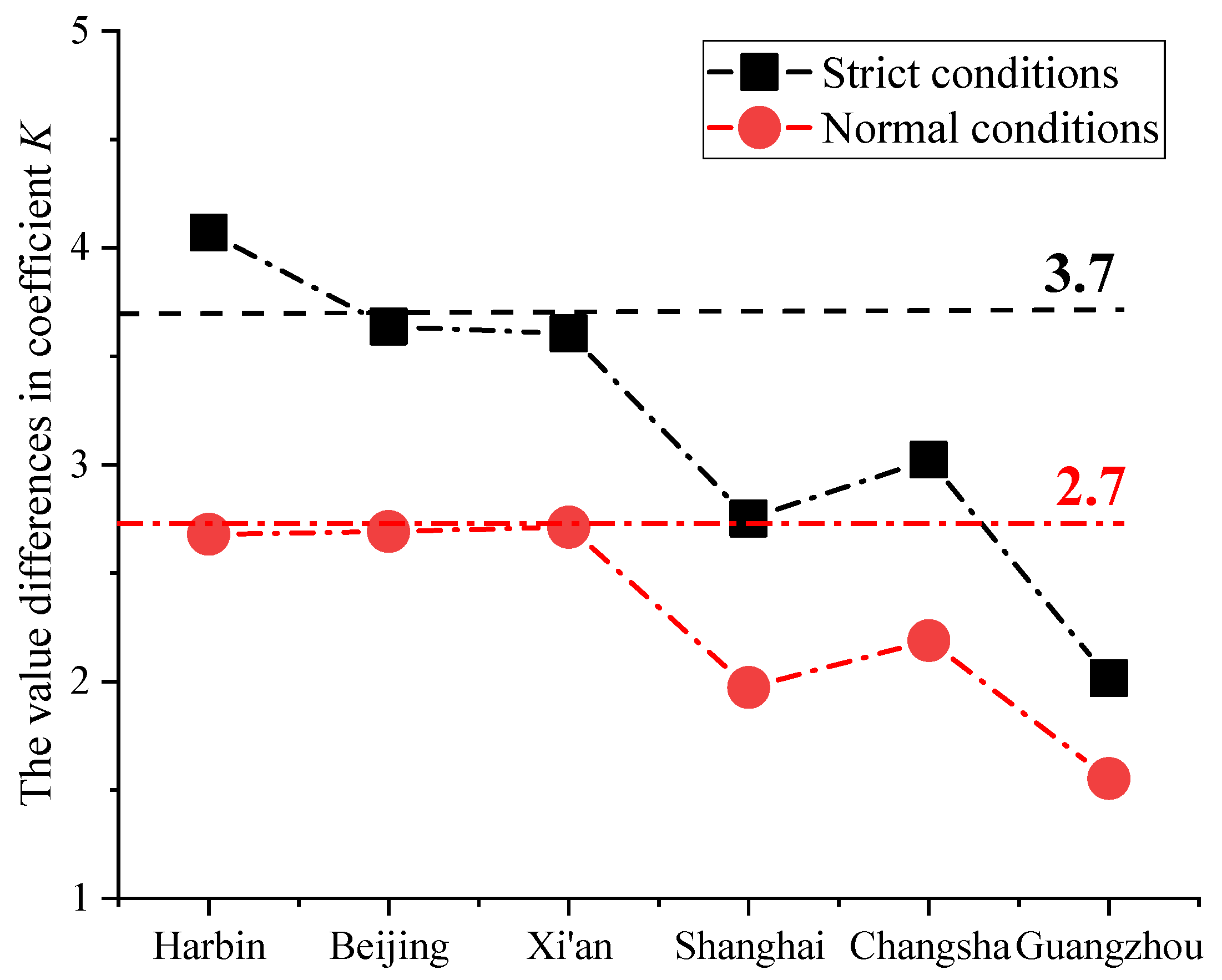
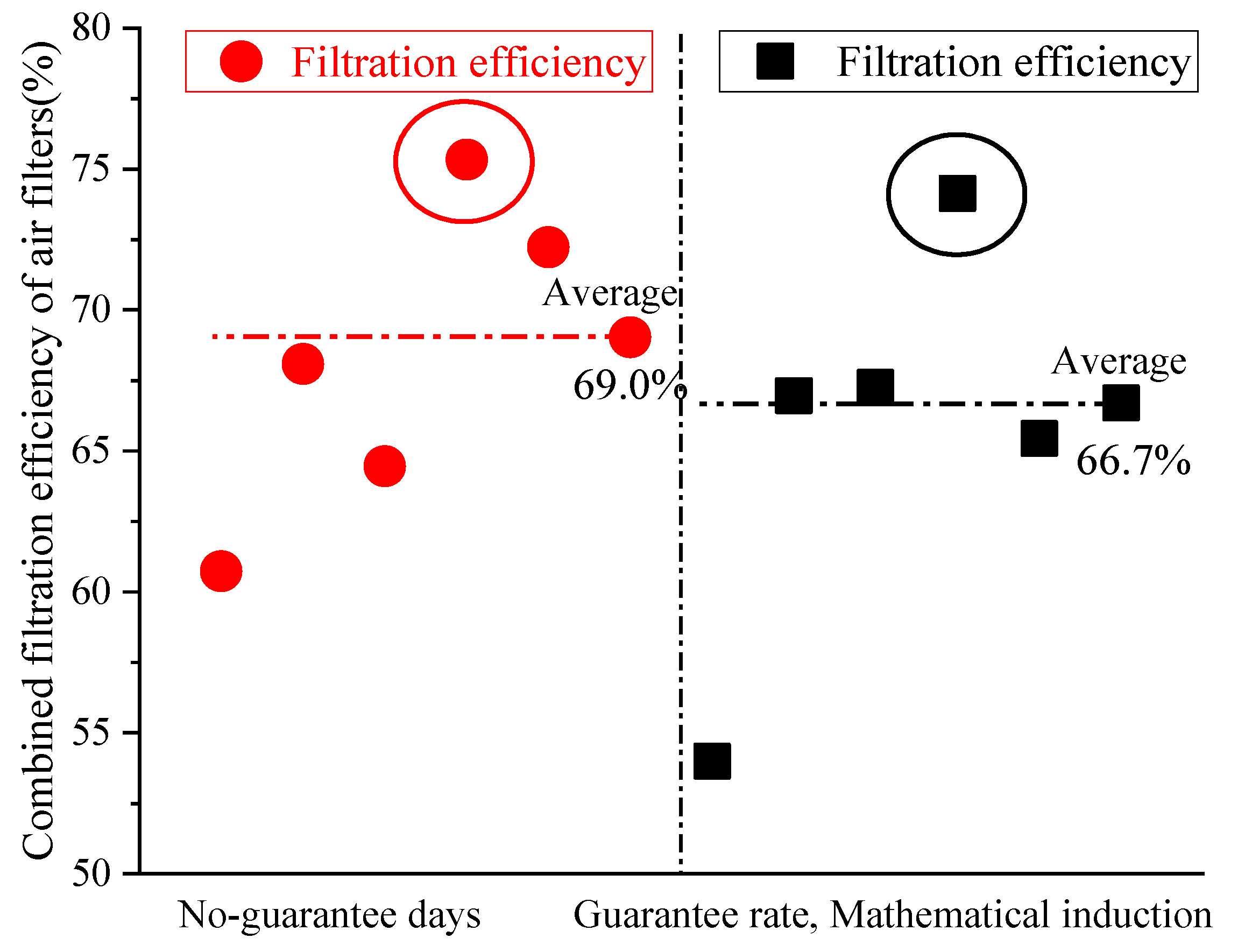
| City | No-Guarantee for 5 Days | No-Guarantee for 10 Days | ||||||||||
|---|---|---|---|---|---|---|---|---|---|---|---|---|
| 2020 | 2019 | 2018 | 2017 | 2016 | Average | 2020 | 2019 | 2018 | 2017 | 2016 | Average | |
| Beijing | 160 | 138 | 194 | 247 | 271 | 202 | 119 | 123 | 167 | 185 | 244 | 167.6 |
| Shanghai | 108 | 99 | 110 | 99 | 135 | 110.2 | 84 | 88 | 98 | 92 | 121 | 96.6 |
| Tianjin | 201 | 174 | 146 | 204 | 256 | 196.2 | 147 | 152 | 119 | 184 | 223 | 165 |
| Chongqing | 90 | 111 | 104 | 145 | 140 | 118 | 79 | 102 | 92 | 131 | 108 | 102.4 |
| Harbin | 253 | 191 | 149 | 291 | 162 | 209.2 | 199 | 166 | 125 | 236 | 140 | 173.2 |
| Changchun | 220 | 153 | 91 | 162 | 138 | 152.8 | 167 | 134 | 83 | 151 | 122 | 131.4 |
| Shenyang | 158 | 174 | 112 | 146 | 169 | 151.8 | 124 | 132 | 100 | 141 | 140 | 127.4 |
| Hohhot | 221 | 150 | 119 | 131 | 127 | 149.6 | 182 | 115 | 99 | 119 | 121 | 127.2 |
| Shijiazhuang | 201 | 228 | 218 | 300 | 436 | 276.6 | 180 | 202 | 200 | 268 | 309 | 231.8 |
| Taiyuan | 178 | 173 | 152 | 267 | 240 | 202 | 158 | 148 | 145 | 199 | 188 | 167.6 |
| Xi’an | 191 | 235 | 211 | 304 | 270 | 242.2 | 156 | 209 | 190 | 260 | 212 | 205.4 |
| Jinan | 166 | 169 | 179 | 228 | 191 | 186.6 | 140 | 157 | 146 | 170 | 179 | 158.4 |
| Urumqi | 216 | 200 | 226 | 308 | 338 | 257.6 | 185 | 190 | 208 | 282 | 285 | 230 |
| Lasa | 28 | 23 | 43 | 51 | 69 | 42.8 | 24 | 21 | 34 | 48 | 65 | 38.4 |
| Xining | 86 | 95 | 98 | 112 | 119 | 102 | 79 | 79 | 88 | 104 | 108 | 91.6 |
| Lanzhou | 82 | 96 | 108 | 129 | 126 | 108.2 | 78 | 84 | 92 | 115 | 112 | 96.2 |
| Yinchuan | 125 | 80 | 86 | 123 | 141 | 111 | 113 | 73 | 76 | 106 | 135 | 100.6 |
| Zhengzhou | 185 | 213 | 229 | 286 | 366 | 255.8 | 146 | 200 | 201 | 216 | 214 | 195.4 |
| Nanjing | 101 | 107 | 167 | 133 | 145 | 130.6 | 90 | 104 | 136 | 96 | 128 | 110.8 |
| Wuhan | 108 | 136 | 136 | 160 | 151 | 138.2 | 99 | 112 | 127 | 142 | 139 | 123.8 |
| Hangzhou | 92 | 96 | 116 | 125 | 123 | 110.4 | 75 | 89 | 101 | 108 | 111 | 96.8 |
| Hefei | 122 | 123 | 143 | 150 | 156 | 138.8 | 100 | 109 | 132 | 126 | 136 | 120.6 |
| Fuzhou | 50 | 54 | 62 | 58 | 68 | 58.4 | 43 | 47 | 54 | 54 | 60 | 51.6 |
| Nanchang | 89 | 92 | 82 | 123 | 136 | 104.4 | 79 | 84 | 74 | 105 | 120 | 92.4 |
| Changsha | 124 | 165 | 147 | 181 | 130 | 149.4 | 111 | 143 | 131 | 157 | 121 | 132.6 |
| Guiyang | 64 | 69 | 75 | 84 | 84 | 75.2 | 56 | 59 | 71 | 79 | 71 | 67.2 |
| Chengdu | 106 | 119 | 126 | 183 | 147 | 136.2 | 102 | 94 | 111 | 172 | 143 | 124.4 |
| Guangzhou | 56 | 67 | 112 | 82 | 82 | 79.8 | 47 | 64 | 91 | 78 | 76 | 71.2 |
| Kunming | 58 | 53 | 61 | 66 | 57 | 59 | 54 | 50 | 57 | 54 | 53 | 53.6 |
| Nanning | 78 | 83 | 88 | 100 | 84 | 86.6 | 62 | 75 | 80 | 89 | 82 | 77.6 |
| Haikou | 47 | 44 | 47 | 61 | 51 | 50 | 41 | 40 | 42 | 53 | 45 | 44.2 |
| Groups (i) | Upper Limit (Ci) | Frequency (Ni) | Relative Frequency (fi) | Cumulative Frequency | Cumulative Relative Frequency |
|---|---|---|---|---|---|
| 1 | 0–25 | 104 | 28.42% | 104 | 28.42% |
| 2 | 25–50 | 144 | 39.34% | 248 | 67.76% |
| 3 | 50–75 | 47 | 12.84% | 295 | 80.60% |
| 4 | 75–100 | 29 | 7.92% | 324 | 88.52% |
| 5 | 100–125 | 16 | 4.37% | 340 | 92.90% |
| 6 | 125–150 | 12 | 3.28% | 352 | 96.17% |
| 7 | 150–175 | 7 | 1.91% | 359 | 98.09% |
| 8 | 175–200 | 4 | 1.09% | 363 | 99.18% |
| 9 | 200–225 | 3 | 0.82% | 366 | 100.00% |
| 10 | 225–250 | 0 | 0.00% | 366 | 100.00% |
| City | Guarantee Rate 97.5% | Guarantee Rate 95% | ||||||||||
|---|---|---|---|---|---|---|---|---|---|---|---|---|
| 2020 | 2019 | 2018 | 2017 | 2016 | Average | 2020 | 2019 | 2018 | 2017 | 2016 | Average | |
| Harbin | 204 | 157 | 153 | 250 | 166 | 186 | 122 | 100 | 105 | 159 | 126 | 122.4 |
| Beijing | 137 | 145 | 182 | 190 | 273 | 185.4 | 102 | 117 | 142 | 118 | 207 | 137.2 |
| Xi’an | 163 | 227 | 229 | 290 | 217 | 225.2 | 133 | 188 | 188 | 195 | 143 | 169.4 |
| Shanghai | 92 | 104 | 103 | 71 | 135 | 101 | 60 | 74 | 70 | 51 | 107 | 72.4 |
| Changsha | 131 | 153 | 148 | 173 | 109 | 142.8 | 102 | 123 | 95 | 122 | 75 | 103.4 |
| Guangzhou | 43 | 76 | 69 | 60 | 61 | 61.8 | 30 | 68 | 51 | 44 | 45 | 47.6 |
| City | 2020 | 2019 | 2018 | 2017 | 2016 | Average | ||||||
|---|---|---|---|---|---|---|---|---|---|---|---|---|
| Strict | Normal | Strict | Normal | Strict | Normal | Strict | Normal | Strict | Normal | Strict | Normal | |
| Harbin | 4.413 | 2.639 | 4.042 | 2.575 | 4.051 | 2.780 | 4.444 | 2.826 | 3.364 | 2.553 | 4.071 | 2.679 |
| Beijing | 3.671 | 2.733 | 3.499 | 2.823 | 3.701 | 2.888 | 3.378 | 2.098 | 3.863 | 2.929 | 3.637 | 2.692 |
| Xi’an | 3.236 | 2.641 | 3.912 | 3.240 | 3.765 | 3.091 | 3.999 | 2.689 | 3.075 | 2.026 | 3.605 | 2.712 |
| Shanghai | 2.955 | 1.927 | 3.035 | 2.159 | 2.902 | 1.972 | 1.855 | 1.332 | 3.040 | 2.410 | 2.751 | 1.972 |
| Changsha | 3.220 | 2.507 | 3.289 | 2.644 | 3.277 | 2.103 | 3.358 | 2.368 | 2.083 | 1.433 | 3.023 | 2.189 |
| Guangzhou | 1.916 | 1.337 | 2.581 | 2.309 | 2.073 | 1.532 | 1.761 | 1.291 | 1.794 | 1.323 | 2.016 | 1.553 |
| City | No-Guarantee for 5 Days (μg/m3) | Guarantee Rate 97.5% | Strict Conditions (μg/m3) | ||||||||||||
|---|---|---|---|---|---|---|---|---|---|---|---|---|---|---|---|
| 2020 | 2019 | 2018 | 2017 | 2016 | 2020 | 2019 | 2018 | 2017 | 2016 | 2020 | 2019 | 2018 | 2017 | 2016 | |
| Harbin | 253 | 191 | 149 | 291 | 162 | 204 | 157 | 153 | 250 | 166 | 204 | 157 | 153 | 250 | 166 |
| Beijing | 160 | 138 | 194 | 247 | 271 | 137 | 145 | 182 | 190 | 273 | 137 | 145 | 182 | 190 | 273 |
| Xi’an | 191 | 235 | 211 | 304 | 270 | 163 | 227 | 229 | 290 | 217 | 163 | 227 | 229 | 290 | 217 |
| Shanghai | 108 | 99 | 110 | 99 | 135 | 92 | 104 | 103 | 71 | 135 | 92 | 104 | 103 | 71 | 135 |
| Changsha | 124 | 165 | 147 | 181 | 130 | 131 | 153 | 148 | 173 | 109 | 131 | 153 | 148 | 173 | 109 |
| Guangzhou | 56 | 67 | 112 | 82 | 82 | 43 | 76 | 69 | 60 | 61 | 43 | 76 | 69 | 60 | 61 |
| Grades | Filtration Efficiency (%) | Grades | Filtration Efficiency (%) |
|---|---|---|---|
| G3 | 15.0~22.3 | F8 | 62.5~81.3 |
| G4 | 24.2~26.5 | F9 | 67.3~81.3 |
| M5 | 25.8~30.2 | H10 | 73.6~82.7 |
| M6 | 24.1~40.7 | H11 | 81.2~97.0 |
| F7 | 43.2~61.6 |
| Combination | Filtration Efficiency (%) | Combination | Filtration Efficiency (%) | Combination | Filtration Efficiency (%) |
|---|---|---|---|---|---|
| G3 + F7 | 51.7~70.2 | G3 + M5 + F7 | 64.2~79.2 | G4 + M5 + F7 | 68.1~80.3 |
| G3 + F8 | 68.1~85.5 | G3 + M5 + F8 | 76.3~89.9 | G4 + M5 + F8 | 78.9~90.4 |
| G3 + F9 | 72.2~85.5 | G3 + M5 + F9 | 79.4~89.9 | G4 + M5 + F9 | 81.6~90.4 |
| G3 + H10 | 77.6~86.6 | G3 + M5 + H10 | 83.3~90.6 | G4 + M5 + H10 | 85.2~91.1 |
| G3 + H11 | 84.0~97.7 | G3 + M5 + H11 | 88.1~98.4 | G4 + M5 + H11 | 89.4~98.5 |
| G4 + M6 | 42.5~56.4 | G3 + M6 + F7 | 63.4~82.3 | G4 + M6 + F7 | 67.3~83.3 |
| G4 + F7 | 56.9~71.8 | G3 + M6 + F8 | 75.8~91.4 | G4 + M6 + F8 | 78.4~91.8 |
| G4 + F8 | 71.6~86.3 | G3 + M6 + F9 | 78.9~91.4 | G4 + M6 + F9 | 81.2~91.8 |
| G4 + F9 | 75.2~86.3 | G3 + M6 + H10 | 83.0~92.0 | G4 + M6 + H10 | 84.8~92.5 |
| G4 + H10 | 80.0~87.3 | G3 + M6 + H11 | 87.9~98.6 | G4 + M6 + H11 | 89.2~98.7 |
| G4 + H11 | 85.7~97.8 |
Publisher’s Note: MDPI stays neutral with regard to jurisdictional claims in published maps and institutional affiliations. |
© 2022 by the authors. Licensee MDPI, Basel, Switzerland. This article is an open access article distributed under the terms and conditions of the Creative Commons Attribution (CC BY) license (https://creativecommons.org/licenses/by/4.0/).
Share and Cite
Zhang, X.; Sun, H.; Li, K.; Nie, X.; Fan, Y.; Wang, H.; Ma, J. Comparison of the Application of Three Methods for the Determination of Outdoor PM2.5 Design Concentrations for Fresh Air Filtration Systems in China. Int. J. Environ. Res. Public Health 2022, 19, 16537. https://doi.org/10.3390/ijerph192416537
Zhang X, Sun H, Li K, Nie X, Fan Y, Wang H, Ma J. Comparison of the Application of Three Methods for the Determination of Outdoor PM2.5 Design Concentrations for Fresh Air Filtration Systems in China. International Journal of Environmental Research and Public Health. 2022; 19(24):16537. https://doi.org/10.3390/ijerph192416537
Chicago/Turabian StyleZhang, Xin, Hao Sun, Kaipeng Li, Xingxin Nie, Yuesheng Fan, Huan Wang, and Jingyao Ma. 2022. "Comparison of the Application of Three Methods for the Determination of Outdoor PM2.5 Design Concentrations for Fresh Air Filtration Systems in China" International Journal of Environmental Research and Public Health 19, no. 24: 16537. https://doi.org/10.3390/ijerph192416537
APA StyleZhang, X., Sun, H., Li, K., Nie, X., Fan, Y., Wang, H., & Ma, J. (2022). Comparison of the Application of Three Methods for the Determination of Outdoor PM2.5 Design Concentrations for Fresh Air Filtration Systems in China. International Journal of Environmental Research and Public Health, 19(24), 16537. https://doi.org/10.3390/ijerph192416537






